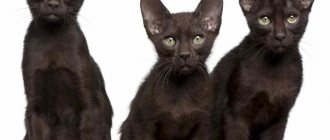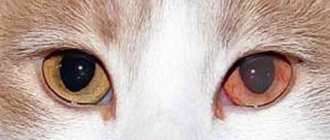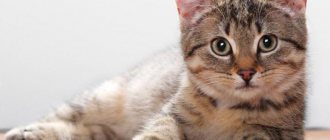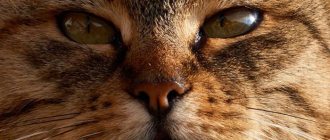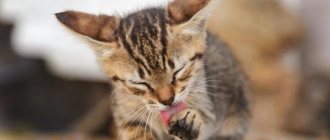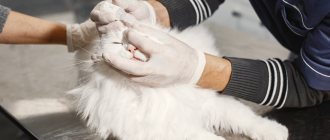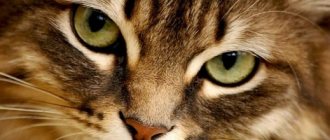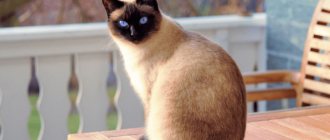People have long paid attention to the peculiarities of cat vision. Ancient man navigated in the dark much better than modern man. But even he was far from a cat, the sensitivity of whose luminous eyes is many times higher than ours. As a result, cats were attributed magical properties, and some peoples even deified them.
With the reign of the medieval Inquisition, difficult times came for cats. They had to suffer greatly due to human superstitions. Now they were considered fiends of hell, accomplices of witches and sorcerers. It is unknown how it would have ended if not for the outbreak of plague carried by rodents. Cats helped control epidemics by eating rats and mice.
Today those days are far behind us, but many people still wonder: why do cat eyes glow in the dark? Do they emit light? Fortunately, now there is no need to guess anymore. Scientists zoologists have long answered this riddle. It's all about the structure of a cat's eye.
How does a cat's eye work?
The eyes of a cat are an amazing phenomenon. For example, the ratio of the eyeball to the entire head of an animal is 20%! This is the largest indicator of all existing ones. And also, unlike many representatives of the fauna, cats' eyes consist of three layers, each of which is responsible for its own function.
Diagram of the structure of a cat's eye.
- The retina, or retina, is the innermost layer of the eye and is responsible for color correction and overall light perception. The retina contains two types of photoreceptors:
- cones – color perception, the ability to see a clear picture, distinguish small details;
- rods – formation of vision, reception and transmission of light.
It is precisely because a cat's eye is rod-dominated that they can see with virtually no light.
Note!
The idea that cats see in complete darkness is wrong. In order for an animal to see its surroundings, at least a minimal amount of light must enter its eye.
There is a “blind spot” in the retina - an area in which there are no photoreceptors and the information falling on it is not perceived by the animal in any way.
Immediately behind this zone there is a disk that focuses all incoming light onto itself. This disc is called the “corpus luteum.”
In the very depths of a cat's eye there is a small plate that looks like liquid silver or a mirror. This plate is called tapetum.
2. Choroid - this layer provides the entire eye with important microelements, such as, for example, oxygen. In the same layer is the ciliary body, which holds the eye lens in the desired position with the help of muscles.
3. Fibrous membrane - the outer layer, which includes:
- sclera - covers almost the entire surface of the eye (3/4 of the part)
- cornea - occupies the remaining space and is responsible for receiving and transmitting light for further processing.
This shell consists of the protein elastin and collagen fibers. It protects internal processes from external influences.
Tapetum and its main function.
Unlike the human eye, a cat's eye has a tapetum, a layer of cells at the very back of the retina that reflects unabsorbed light onto the retina. It is thanks to the tapetome that cats' eyes glow.
The main function of the tapetum.
Features of vision of cats
The internal organs of a cat are identical to those of other mammals. The same cannot be said about the senses, including the eyes. They are endowed with special properties necessary for the normal functioning of a predator.
In complete darkness, an animal's vision is no different from a human's. In dim light, their orientation improves significantly. The ability to process any accessible light source is increased.
Advantage of the cat's gaze:
- large pupil and lens;
- close location of the cornea to the retina;
- roundness and contraction of the eyeball;
- extended viewing angle.
Glowing eyes
Cats have the ability to accumulate light. The mechanism is called “luminous wallpaper”. It is located behind the retina and consists of 15 spheres.
The functioning of an animal's eyes is similar to the working principle of a camera. Light rays sneak through the hole, the dimensional frequencies of which are modified. The quantitative composition of light is controlled by the iris, and focused by the lens. Envelopment of the retina occurs. It sends an impulse to the brain center.
The retina is endowed with sensory cells:
- The first: is responsible for excellent vision at night and sensitivity to movement in dim flickering lamps.
- The second has resolving power.
- The slit pupil provides protection from bright flickering light.
A cat has binocular vision, just like a human. Due to the stereoscopic effect, the predator assesses the reach of prey. glowing eyes
Causes of glowing eyes.
Cats are very ancient creatures. Their history goes back to ancient Egypt and beyond. The glow of a cat's eyes caused fear among unenlightened people. And only then – interest. That is why, in addition to the scientific explanation, you can find many traditions and legends that explained this in the old days.
Scientific explanation.
The tapetum is a thin layer of cells deep in the eyeball of animals. It is also called a “mirror”, because the main function of the tapetum is to reflect light onto the retina of the eye.
It is the tapetum that explains the reasons for the glowing eyes of a cat. However, like many other animals that are nocturnal.
In this case, the glow in the cat’s eyes can be of different colors. For example, in kittens up to 3-4 months of age, the reflection has a reddish tint, because their retinal pigmentation is weak and the reflective layer is not formed. In adult cats, the color can be green or yellow - this color gives the rich luminescent pigment of the tapetum. In cats whose pigment is weaker, the eyes may glow bluish, reddish or even purple.
Another factor that affects color is the angle of light hitting the cat's eye. If the rays come from the side, you will notice that the eyes glow more blue. And if the light hits directly - yellow or green.
Interestingly, even one cat can have a different color. For example, the right eye shines yellow, and the left eye shines red. This may be due to several reasons:
- pathology or injury of one eye;
- light beam hitting at different angles;
- congenital difference in pigment saturation.
An example of different colors in one animal.
Myths and legends.
It is much more interesting to read the old beliefs that explained the glow of the eyes to the unenlightened people of past centuries.
Egypt
In ancient Egypt, the cat was considered an assistant to the lunar goddess Bastet.
Bastet protected people from the evil hiding in the dark, but since she couldn’t keep track of everyone alone, she sent people a cat. The Egyptians regarded the burning eyes of a cat as direct communication between a pet and the goddess. At such moments, it was impossible to interfere with the animal, because Bastet could punish for disrespect.
Rome
In ancient times, there lived a cruel circus owner in Rome. There were many animals in his cages and all suffered from cruelty and abuse. And only one cat managed to escape. For this, Libertas - the Roman goddess of freedom - endowed the animal with the ability to illuminate its path to freedom with the help of fire in its eyes. This is how the Romans explained the glow of a cat’s eyes, whose purring pet was an animal of freedom and will.
Japan
In the land of the rising sun, cats were the guardians of the Maneki-Neko Temple. It counted. that whoever gets the light from the cat’s eyes will be doomed to good luck and happiness.
Europe
But in medieval Europe, cats were considered familiars of witches and servants of hell. It was believed that the cat's eye burns with the flame of Satan and promises failure and misfortune.
Russia
In Orthodox Russia, cats are protectors and servants of God.
The light in the eyes is the light of the Lord himself, who created the cat as a protector of man from creatures living in darkness. These are the different myths and legends that surround the glow of a cat's eye. This phenomenon gained great popularity among people before scientists were able to understand the true causes of the biological phenomenon.
These are the different myths and legends that surround the glow of a cat's eye. This phenomenon gained great popularity among people before scientists were able to understand the true causes of the biological phenomenon.
Cat skills
Cats have been domesticated since ancient times. It’s interesting that no matter how hard people try to completely domesticate the purr, nothing works. Cats have been and remain versatile and the most successful hunters in the world. In everyday situations, cats are calm and affectionate, but have you ever seen a purr when angry? Their strength, agility and ability to inflict wounds are so deeply embedded in their DNA that even the most peaceful pet can greatly surprise its owner.
Cats belong to a large family and are relatives of pumas, lynxes, ocelots, tigers, and lions. People became interested in domesticating these magnificent creatures even before our era. It’s interesting, but cats became people’s companions earlier than dogs. How an ancient, vulnerable man came up with the idea of encroaching on the will of a universal predator is not entirely clear. However, the fact remains that cats have lived next to people for centuries, they are loyal in their own way, but there is still something wild in them. If you carefully observe your pet, you will find in its gait and manners many features similar to wild cats. There is only one reason: the cat is a hunter and its skills have not atrophied despite domestication.
For what merits did the cat receive the title of best hunter? This list is quite long, but there is one key factor - success
It doesn't matter if the cat is wild or domestic, it will have a number of skills:
- Silent gait and ability to sneak.
- Sharp teeth and fangs with grooves that allow normal breathing while holding the victim.
- Acute sense of smell.
- Sensitive hearing.
- Agility, flexibility, ability to move in difficult terrain.
- Acute vision and the ability to record any movements of the victim at a great distance.
- Wide angle of lateral vision.
- The ability to hunt in the dark as in the light is the main and very remarkable feature of cats, given that they are not nocturnal animals.
Cats are generalists; they can hunt during the day, at dusk and at night, while most predators hunt at certain times of the day. The eyes of a cat are very sensitive and vulnerable, at the same time they are the main “weapon” and mystery of the purr.
How to explain to children.
The owners of the furry creature and at the same time parents may notice their child’s tension in the evenings at certain times. For example, a baby absolutely does not want to let a cat into his room at night. Or he tries to avoid contact with his pet altogether. There can be many reasons and you need to deal with them immediately. And a fairly common cause is the glow of the animal’s eyes in the dark, which can frighten the baby.
Cats and children are best friends.
There are different ways to explain to children the reason for glowing cat eyes. Believing families can explain this phenomenon with a legend from their religion. For example, Christians can talk about the Lord who endowed a cat with his light so that it would drive away darkness from its owners.
If the parent does not want to mislead the child and wants to explain everything scientifically, a question arises. How can this be done so as not to break the baby’s brain, but so that he understands everything? And it turns out it's quite easy.
You can show the child a mirror and explain that in the eyes of a cat there is the same small mirror that reflects light, which is why such a phenomenon as the glow of the eyes appears.
You can show your child how it all works using a simple example. To do this, you need to take a flashlight and shine the light on the mirror. The flashing bright spot can be associated with the glowing cat's eyes, explaining to the child that the cat's eye works the same way.
Features of vision
So, we looked at the components of a cat's eye. Now all that remains is to draw conclusions and learn about the features.
- Even the naked eye can see that our pets’ visual organs are set quite deep. Therefore, it is more difficult for them to see objects located on the periphery. This same feature explains the limited mobility of the eye itself.
- The pupil is located vertically. Its size depends entirely on the lighting. The stronger it is, the narrower it is. In daylight, it completely turns into a narrow crack. The fact is that this number of light rays (which pass through it) will be enough to provide complete information to the brain about the surrounding environment.
- Direct exposure to sunlight is harmful to the eyes. It's all about their increased sensitivity. On average, it is 7 times greater than that of humans.
- Each eye has its own visual field. That is, the area around from which it reads information (receives a stream of light). The fields of the left and right eyes intersect. This explains the fact that cats see three-dimensional images.
- Our pets have color vision, although it is different from ours. They perfectly distinguish shades of the upper spectrum (blue, indigo, green). But they see all shades of red in gray. The same applies to colors such as orange and yellow.
- If it is easier for us to see any object in a static state, then for born hunters the emphasis is shifted to moving objects. This feature becomes critical in the wild. This is why the cat will notice even the slightest movement or movement in the apartment.
- A cat has no blind spots. Drivers are very familiar with this concept. But some herbivores also have places that they simply cannot see. They are located directly in front of the animal's muzzle. For hunters, this is unacceptable.
Lack of light in the cat's eyes.
Eyes that do not reflect light
In healthy cats and kittens, the tapetum always reflects incoming light rays onto the retina, which is why the cat's eyes glow in twilight and partial darkness. This is normal and one of the basic biological processes characteristic of animals that are nocturnal. If at least some part of a pet’s eye does not function, this is a reason for the owner to think and tense up.
The absence of glow indicates problems with luminescent pigmentation of the eyeball and a lack of taurine sulfonic acid and other amino acids. This is caused by various injuries and diseases.
Taurine is a sulfonic acid that is responsible for many processes in the body. Unlike other animals, cats cannot produce this acid on their own and only get it from animal foods.
That is why owners should monitor their pet’s health and nutrition. And this is precisely what answers the question of why pets need a balanced diet.
An example of the partial absence of luminescent pigment.
Is it a pathology?
The absence of light reflection in the eyeball clearly indicates pathology and health problems of the animal. Most often, such problems affect elderly and old cats - the lens of the eye thickens and begins to reflect less light.
Problems may also indicate a serious cat disease such as cataracts or glaucoma. Or for injuries that can be received by a pet under various circumstances - from an accident at home, ending with the outcome of a fight between another cat or dogs.
The pathology of lack of light reflection can accompany a kitten from its very birth. There is no way to influence this process without surgical intervention. Why might this happen? Due to improper formation of fetal organs in the womb. However, in this situation, the kittens live and grow up safely, and there is no risk of death. But it can lead to problems with other body processes.
How to treat.
Attention!
If you suspect a health problem with your pet, you should immediately contact a veterinary clinic or veterinarian! Under no circumstances should you self-medicate an animal!
Only a veterinarian can tell you how to treat pathologies of a cat’s eyeball. It is better not to self-medicate, as well as look for medications and help on the Internet.
But you can protect your pet from diseases. There are many different ways to do this that are available to any responsible owner.
Cats and vitamins.
- If your cat has access to the outdoors, you should be more attentive to its surroundings and monitor the animal, trying to prevent fights or attacks by larger animals.
- It is necessary to ensure that the animal gets taurine. The pet products market offers a sufficient amount of food that already contains the necessary amino acids. Even more essential substances can be found in vitamins and dietary supplements for animals.
- If your animal is fed at home, you should always ensure that the diet includes foods containing taurine. Such products include chicken, fish, beef, turkey, cheese, dairy and fermented milk products.
- Timely consultations and preventive examinations with a veterinarian are the key to the health of the pet and the peace of mind of the owner.
If your cat has eye health problems, don’t panic right away. Thanks to numerous clinics and accessible veterinary medicine, you can take the problem into your own hands and quickly help your beloved animal without consequences or serious intervention.
Healthy cat.
